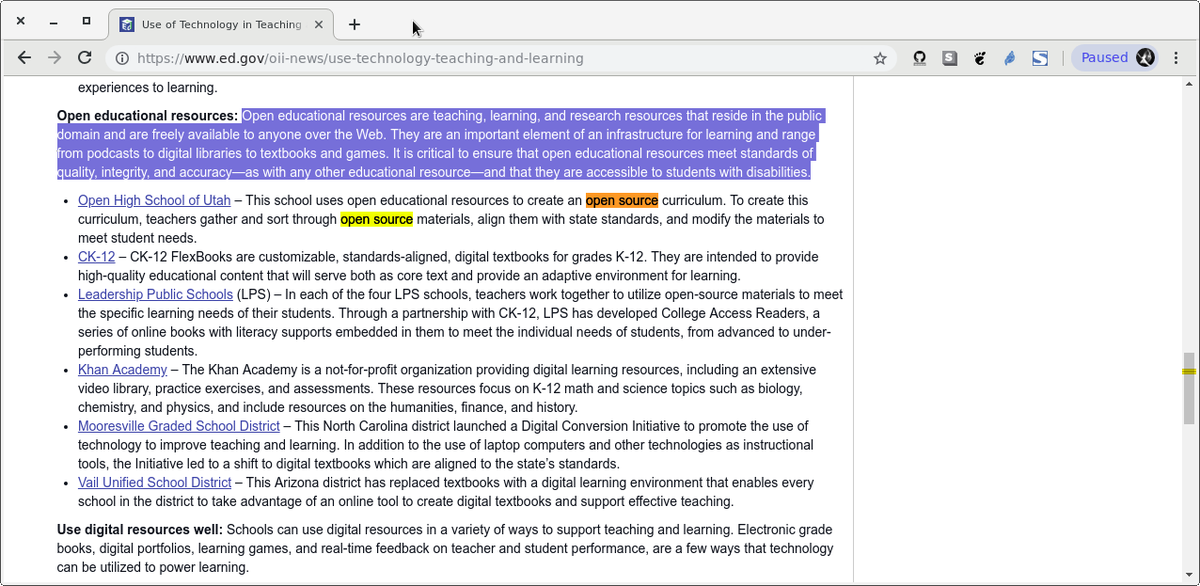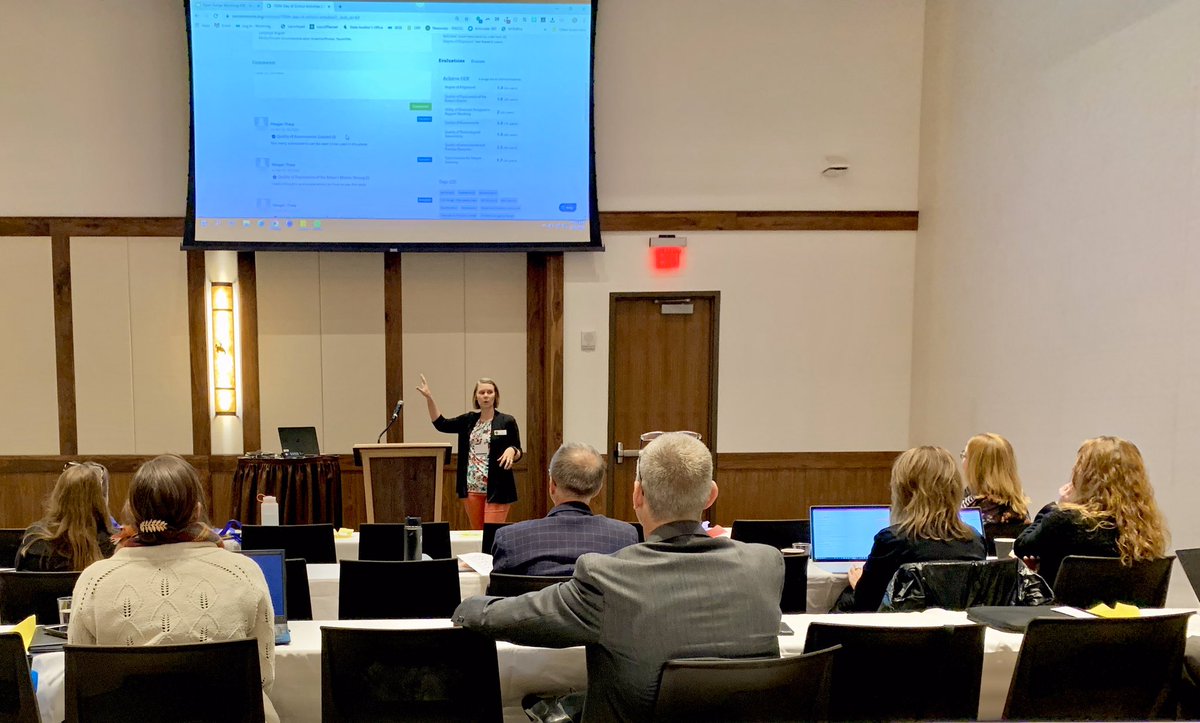UNESCO International Open Educational Resources Logo Open educational resources (OER) are easily accessible, honestly certified text, media, and other digital assets that are helpful for teaching, discovering, and assessing along with for research study purposes. The term OER describes openly available products and resources for any user to utilize, re-mix, improve and rearrange under some licenses.
The concept of open instructional resources (OER) has various working definitions. The term was first created at UNESCO's 2002 Online forum on Open Courseware and designates "teaching, finding out and research products in any medium, digital or otherwise, that live in the public domain or have been launched under an open license that permits no-cost gain access to, use, adaptation and redistribution by others without any or limited constraints.
Often mentioned is the William and Plants Hewlett Foundation term which utilized to define OER as: OER are teaching, discovering, and research study resources that live in the general public domain or have actually been launched under a copyright license that allows their complimentary usage and re-purposing by others. Open academic resources consist of complete courses, course materials, modules, textbooks, streaming videos, tests, software application, and any other tools, materials, or methods used to support access to knowledge.
The new definition explicitly specifies that OER can include both digital and non-digital resources. Also, it lists several types of use that OER permit, influenced by 5R activities of OER. 5R activities/permissions were proposed by David Wiley, that include: Retain - the right to make, own, and control copies of the content (e.g., download, replicate, shop, and handle) - the right to utilize the content in a wide variety of ways (e.g., in a class, in a research study group, on a site, in a video) Revise - the right to adjust, change, customize, or alter the content itself (e.g., equate the material into another language) Remix - the right to combine the initial or revised material with other material to create something brand-new (e.g., include the material into a mashup) Redistribute - the right to share copies of the original content, your modifications, or your remixes with others (e.g., provide a copy of the content to a good friend) Users of OER are enabled to take part in any of these 5R activities, permitted by the usage of an open license.
OER includes discovering content, software tools to establish, utilize, and disperse content, and implementation resources such as open licences". (This is the meaning mentioned by Wikipedia's sis project, Wikiversity. If you beloved this article and also you would like to acquire more info concerning Open Educational Resources Textbooks please visit our webpage. ) By way of contrast, the Commonwealth of Knowing "has actually embraced the widest meaning of Open Educational Resources (OER) as 'products offered freely and openly to utilize and adapt for teaching, discovering, development and research'".
If you beloved this article and also you would like to acquire more info concerning Open Educational Resources Textbooks please visit our webpage. ) By way of contrast, the Commonwealth of Knowing "has actually embraced the widest meaning of Open Educational Resources (OER) as 'products offered freely and openly to utilize and adapt for teaching, discovering, development and research'".
The above definitions expose some of the tensions that exist with OER: Nature of the resource: Numerous of the meanings above limit the meaning of OER to digital resources, while others consider that any educational resource can be included in the meaning. Source of the resource: While a few of the definitions require a resource to be produced with a specific instructional aim in mind, others broaden this to include any resource which might possibly be used for knowing.
Others require only that free usage to be approved for academic purposes, perhaps excluding business usages. These definitions likewise have typical elements, particularly they all: cover use and reuse, repurposing, and adjustment of the resources; include complimentary usage for instructional functions by instructors and students incorporate all kinds of digital media.
For this factor, it might be as handy to consider the distinctions between descriptions of open educational resources as it is to consider the descriptions themselves. Among a number of stress in reaching an agreement description of OER (as found in the above definitions) is whether there need to be explicit emphasis positioned on specific innovations.
A book can be honestly licensed and easily used without being an electronic document. This technologically driven stress is deeply bound up with the discourse of open-source licensing. For more, see Licensing and Kinds Of OER later in this article. There is also a stress in between entities which find worth in quantifying use of OER and those which see such metrics as themselves being unimportant to free and open resources.
While a semantic difference can be made defining the technologies used to gain access to and host knowing material from the material itself, these innovations are generally accepted as part of the collective of open academic resources. Considering that OER are intended to be readily available for a range of academic functions, most companies utilizing OER neither award degrees nor supply scholastic or administrative support to trainees seeking college credits towards a diploma from a degree giving accredited organization.
In order for educational resources to be OER, they must have an open license. Many academic resources made available on the Web are geared to permitting online access to digitised instructional content, but the products themselves are restrictively accredited. Thus, they are not OER. Typically, this is not deliberate. The majority of educators are not knowledgeable about copyright law in their own jurisdictions, never mind worldwide.
The Creative Commons license is the most widely used licensing framework worldwide used for OER. The term learning things was coined in 1994 by Wayne Hodgins and rapidly gained currency among educators and training designers, popularizing the concept that digital products can be designed to allow easy reuse in a vast array of mentor and discovering situations.
OER and Free/Libre Open Source Software (FLOSS), for example, have numerous aspects in common, a connection first established in 1998 by David Wiley who created the term open content and introduced the principle by example with open source. Richard Baraniuk made the same connection individually in 1999 with the starting of Connexions (now called OpenStax CNX).
In a very first manifestation of this motion, MIT went into a partnership with Utah State University, where assistant teacher of instructional technology David Wiley set up a dispersed peer assistance network for the OCW's content through voluntary, self-organizing communities of interest. The term "open academic resources" was very first embraced at UNESCO's 2002 Online forum on the Effect of Open Courseware for College in Developing Nations.
The report "Providing Knowledge for Free: The Emergence of Open Educational Resources", published in May 2007, is the primary output of the project, which included a variety of professional meetings in 2006. In September 2007, the Open Society Institute and the Shuttleworth Structure assembled a meeting in Cape Town to which thirty leading advocates of open education were welcomed to work together on the text of a manifesto.
The worldwide movement for OER culminated at the 1st World OER Congress assembled in Paris on 2022 June 2012 by UNESCO, COL and other partners. The resulting Paris OER Declaration (2012) reaffirmed the shared dedication of global companies, federal governments, and institutions to promoting the open licensing and free sharing of openly funded content, the development of nationwide policies and strategies on OER, capacity-building, and open research study.
The resulting Paris OER Declaration (2012) reaffirmed the shared dedication of global companies, federal governments, and institutions to promoting the open licensing and free sharing of openly funded content, the development of nationwide policies and strategies on OER, capacity-building, and open research study.





